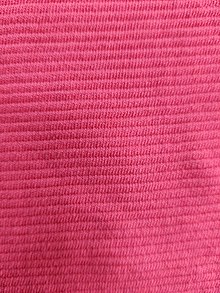Ottoman (textile)
Ottoman is a crosswise rib pattern with a pronounced ribbed or corded effect, may be knitted or woven. Ottoman is a stiff, heavyweight, crosswise rib structure.[1] In weaving it is a warp faced fabric showing bold weft way rib. The ribbed effect is created by using fine warp yarn with a heavier weft yarn. In knitting, Ottoman rib pattern is knitted with double jersey machines. The ribs lines in an Ottoman may vary in size from thin to coarser by selecting yarny Yarn count and gauge.[2]

Derivation
French ottomane, fem. of ottoman OTTOMAN.[2]
Origin
Ottoman is a weaving art from Turkey.[3]
Characteristics
Ottoman is a heavy ribbed structure, it is a stiff structure difficult to gather and shirred. It has tendency to slip at seams like other rib structures. Ottoman is difficult to wear very tightly.[2]
Composition
Ottoman with silk was most popular. it is also made with a mixture of cotton and other silk like yarns. Ottoman made of pure silk is very expensive so artificial silk is used instead to create a cheaper alternative. Ottoman may be produced with cotton, wool, rayon and silk or other natural and synthetic blends according to the end-use.[4][2]
Use
Ottoman is used for various purposes from dressing material to upholstery. It is usable for evening wraps, formal coats, dress and in particular, legal dress (such as QC gowns) and academic dress (mostly for hoods). Grosgrain is similar to Ottoman but it is thinner and lighter than Ottoman and is used mostly for ribbons.[2]
References
- ^ "Product Guides - Glossary". 2012-05-10. Archived from the original on 2012-05-10. Retrieved 2020-10-23.
- ^ a b c d e Tregonning, Melwyn. Fabric Dictionary.
- ^ Gürsu, Nevber (1988). The Art of Turkish Weaving. Redhouse Press. p. 68. ISBN 9789754130362.
- ^ Faroqhi, Suraiya (2016). A Cultural History of the Ottomans. Bloomsbury. p. 185. ISBN 9780857727824.
